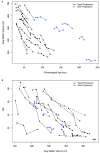Molecular Bases of Neurodegeneration and Cognitive Decline, the Major Burden of Sanfilippo Disease
- PMID: 32012694
- PMCID: PMC7074161
- DOI: 10.3390/jcm9020344
Molecular Bases of Neurodegeneration and Cognitive Decline, the Major Burden of Sanfilippo Disease
Abstract
The mucopolysaccharidoses (MPS) are a group of diseases caused by the lysosomal accumulation of glycosaminoglycans, due to genetic deficiencies of enzymes involved in their degradation. MPS III or Sanfilippo disease, in particular, is characterized by early-onset severe, progressive neurodegeneration but mild somatic involvement, with patients losing milestones and previously acquired skills as the disease progresses. Despite being the focus of extensive research over the past years, the links between accumulation of the primary molecule, the glycosaminoglycan heparan sulfate, and the neurodegeneration seen in patients have yet to be fully elucidated. This review summarizes the current knowledge on the molecular bases of neurological decline in Sanfilippo disease. It emerges that this deterioration results from the dysregulation of multiple cellular pathways, leading to neuroinflammation, oxidative stress, impaired autophagy and defects in cellular signaling. However, many important questions about the neuropathological mechanisms of the disease remain unanswered, highlighting the need for further research in this area.
Keywords: Sanfilippo syndrome; molecular bases; mucopolysaccharidosis III; neurodegeneration.
Conflict of interest statement
The authors declare no conflict of interest.
Figures

References
-
- Neufeld E.F., Muenzer J. The Mucopolysaccharidoses. In: Valle D., Antonarakis S., Ballabio A., Beaudet A., Mitchell G.A., editors. The Online Metabolic and Molecular Bases of Inherited Disease. McGraw-Hill Education; New York, NY, USA: 2019.
-
- Sanfilippo S.J., Podosin R., Langer L., Good R.A. Mental retardation associated with acid mucopolysacchariduria (heparitin sulfate type) J. Pediatr. 1963;63:837–838. doi: 10.1016/S0022-3476(63)80279-6. - DOI
-
- Kresse H., Neufeld E.F. The Sanfilippo A corrective factor. Purification and mode of action. J. Biol. Chem. 1972;247:2164–2170. - PubMed
Publication types
Grants and funding
LinkOut - more resources
Full Text Sources
Other Literature Sources
Miscellaneous

